Melissa Shemanna: Artistic Alchemy on Shamanic Paintings and Cultural Roots
Melissa Shemanna, a visionary artist whose work intricately weaves the spiritual with the tangible. Born and nurtured in the rich landscapes of Australia, Melissa’s art transcends traditional boundaries, exploring themes of nature, spirituality, and cultural heritage through shamanic paintings. With over two decades of experience as a Yoga and esoteric teacher, her artistic expressions are deeply rooted in her profound connection to the Earth and its ancient stories. Now based in the UK, Melissa continues to inspire and captivate with her commitment to bringing sacred and visionary art practices to the forefront of the cultural dialogue. In this interview, Melissa shares insights into her creative process, the impact of her cultural roots on her art, and her exciting plans for the future, including her ongoing project, the “Labyrinth of Alchemised Honey.
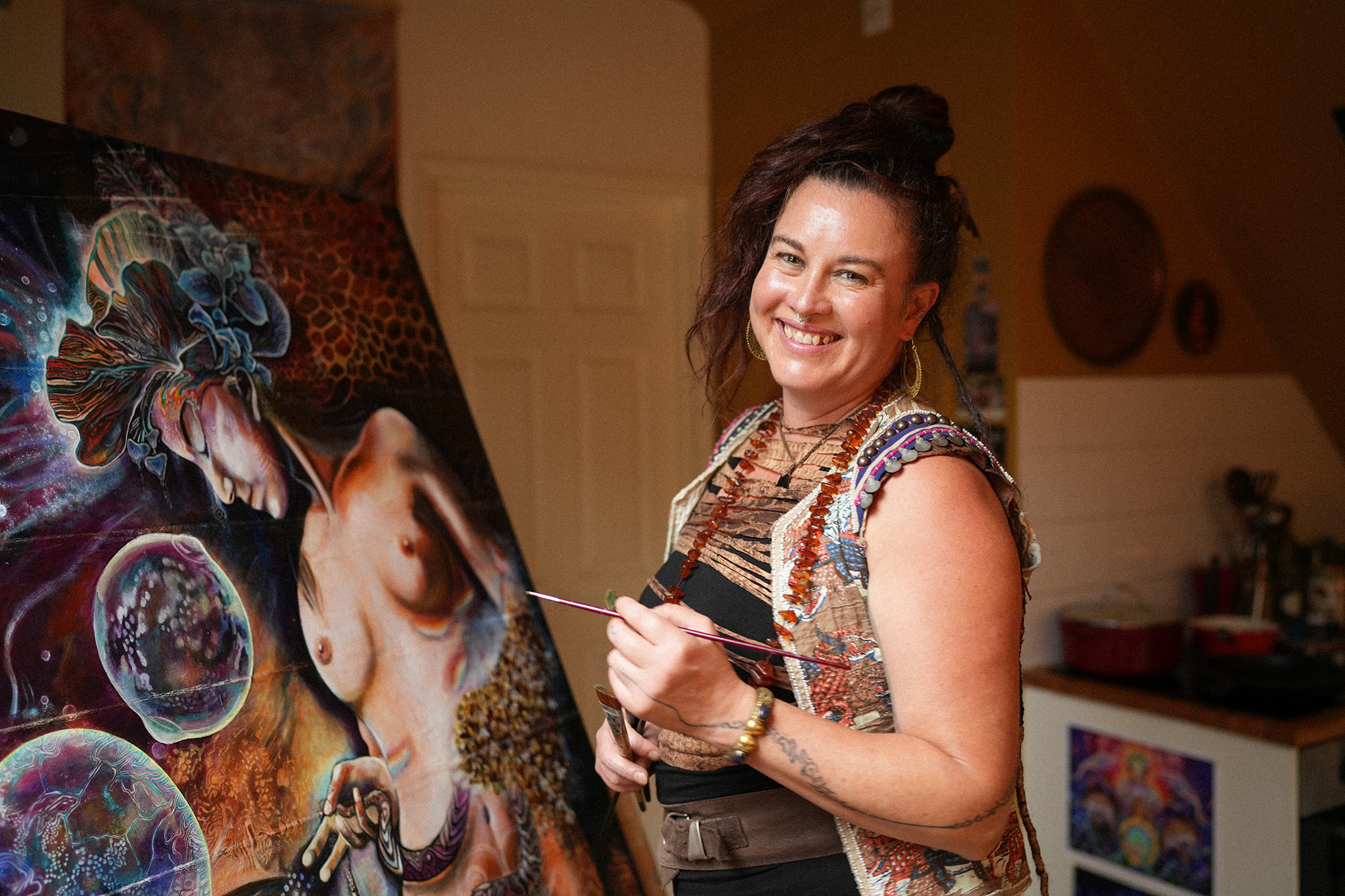
Melissa, you are a well-known painter renowned for your shamanic artworks. Born in Australia, how was it growing up there?
Australia has been a wonderful place to grow up and to expand in the ways of natural environment and also spirituality, both these things have influenced my creative work greatly. I initially lived on the South Coast of Sydney in a beachside community that had lots of wildernesses to explore and freedom that my soul was very grateful for. The freedom in nature that I experienced was a huge part of my upbringing blended with being geographically close enough to the city of Sydney to be able to merge with and dive into international cultures and artistic events. For the past 20 years, I have lived in an off-grid home atop a mountain in Victoria’s Yarra Valley, about 1.5 hours from Melbourne. I have raised my two sons there in a very beautiful, natural, creative and abundant way. They are both now adults and happily living in Melbourne!
What inspired you to start painting? Who are your biggest artistic influences?
I began painting at a very early age and was initially self-taught, though I also had the guidance and encouragement of my family. My great-grandfather was an oil painter based in Sydney, and I was fortunate enough to inherit his paints, brushes, and paint pigments when I was 10 years old. I always knew I would be an artist, as my soul was deeply tuned into the creative flow. I had lucid dreams and was determined to bring them into form in a spiritually awakened way. My family environment was key to my spiritual understanding, immersed in yoga and meditation practices while being surrounded by nature every day. I am grateful for the nurturing that this brought to me. It unfolded my interest in esoteric, shamanic, and mythical ideas and concepts, which I was keen to evolve.
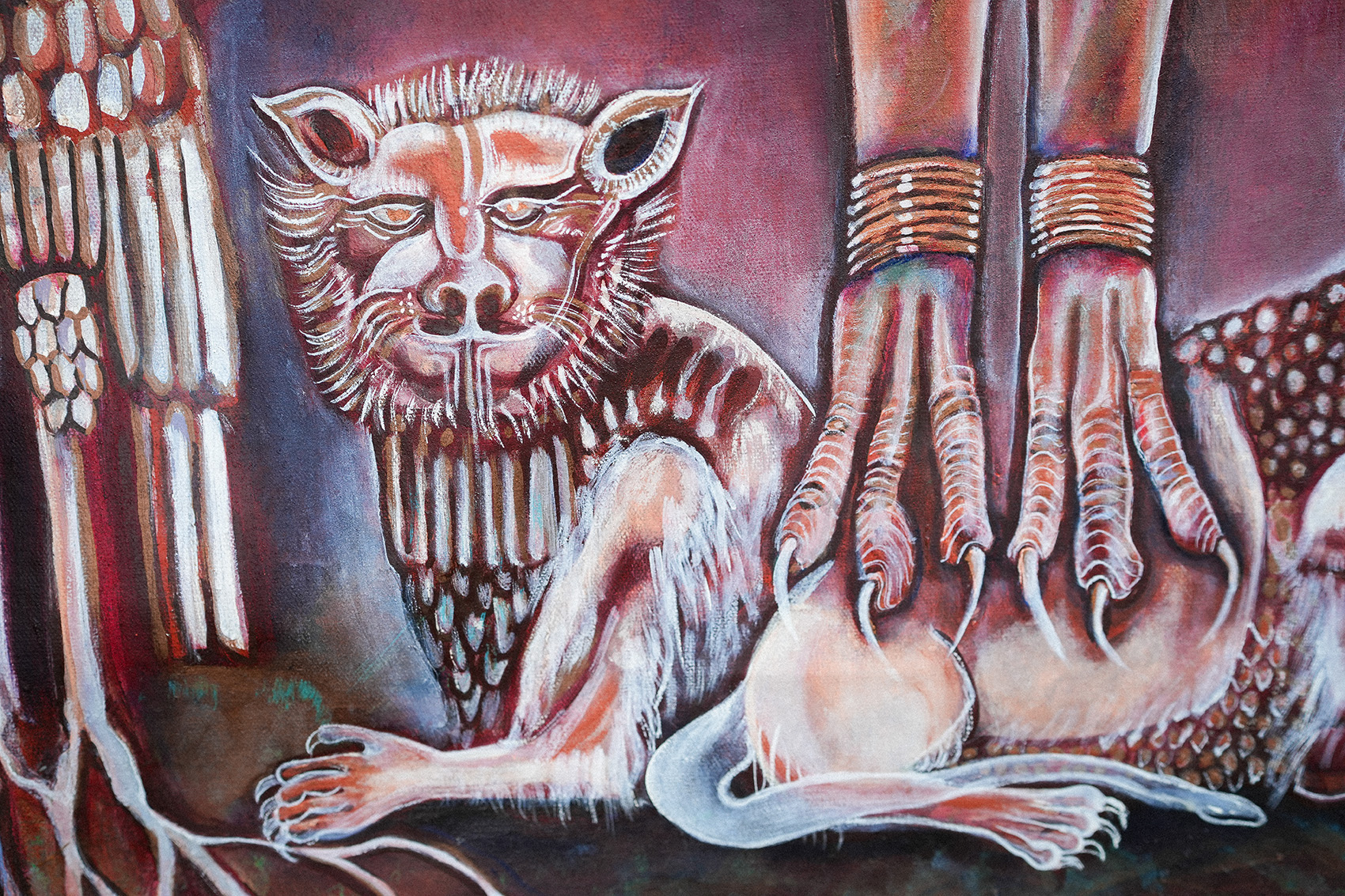
Can you share a bit about your journey as an artist? How has your style evolved over the years?
My journey as an artist was quite determined by the age of 5 when I seriously began to study Leonardo DaVinci and some of the other old masters’ works in painting and drawing. I have been dedicated to learning, developing, and growing my artistic practice ever since. Beginning with a focus on drawing and oil painting, I earned a fine arts degree from Wollongong Arts College in 1994. Since then, I have had many painting mentors over the years. Most notably, I participated in a live-in residency in Italy in 2011, where I learned the old masters’ style of painting using egg tempera and oil glazing, known as Mischtechnik (mixed technique), from Laurence Caruana (Austria), Maura Holden (USA), and Amanda Sage (USA). This technique, part of a lineage originating from Austrian artist Ernst Fuchs, embellishes spiritual and visionary themes. I also studied in Bali in 2013 in a live-in painting residency with another of Ernst Fuchs’ longtime students, Wolfgang Widmoser. Additionally, I had an excellent six-year apprenticeship with Bruno Torfs at Bruno’s Sculpture Garden in Marysville, VIC, Australia, where I learned about spiritual concepts and artistic mediums, including sculpting with clay, while maintaining the garden and sculptures. My journey as an artist has been a continuous conscious evolution and a devoted path for as long as I can remember, and it will continue to be so.

Can you explain what ‘shamanic painting’ means to you and how it manifests in your work?
The term ‘shamanic painting’ is a profound element of my creative and spiritual journey. I have always been deeply connected to the realms of magic and mystery in nature and consciousness. My work seeks to express and crystallize the majesty of the cosmos through the conduit of consciousness, honouring the sacred reciprocity within all things interconnected within the web of life. My paintings emerge from this space—the threshold of form and formlessness, the nuanced knowledge our souls hold, and the mythopoetic realms that seek expression through original thought forms imbued with cosmic awareness. Shamanic painting is not just an art form; it is a way of life that has unfolded before me. Throughout my life, I’ve been driven by curiosity about the broader universe, which I honor through visionary, symbolic artmaking. My work incorporates dreams, esoteric knowledge from various pathways and traditions I’ve been initiated into—including Yogic traditions, Tibetan Buddhism, 13 Moon women’s circles, Honeybee medicine, Indigenous Australian knowledge, Native American tribal traditions, Western esoteric practices, and plant medicine ceremonies—inspired by Mother Nature herself. This collective wisdom infuses my paintings, creating a language that invites others to experience and feel deeply. As a medicine woman with a Honeybee Totem, much of my work reveals the shamanic and sacred ways of the bee.
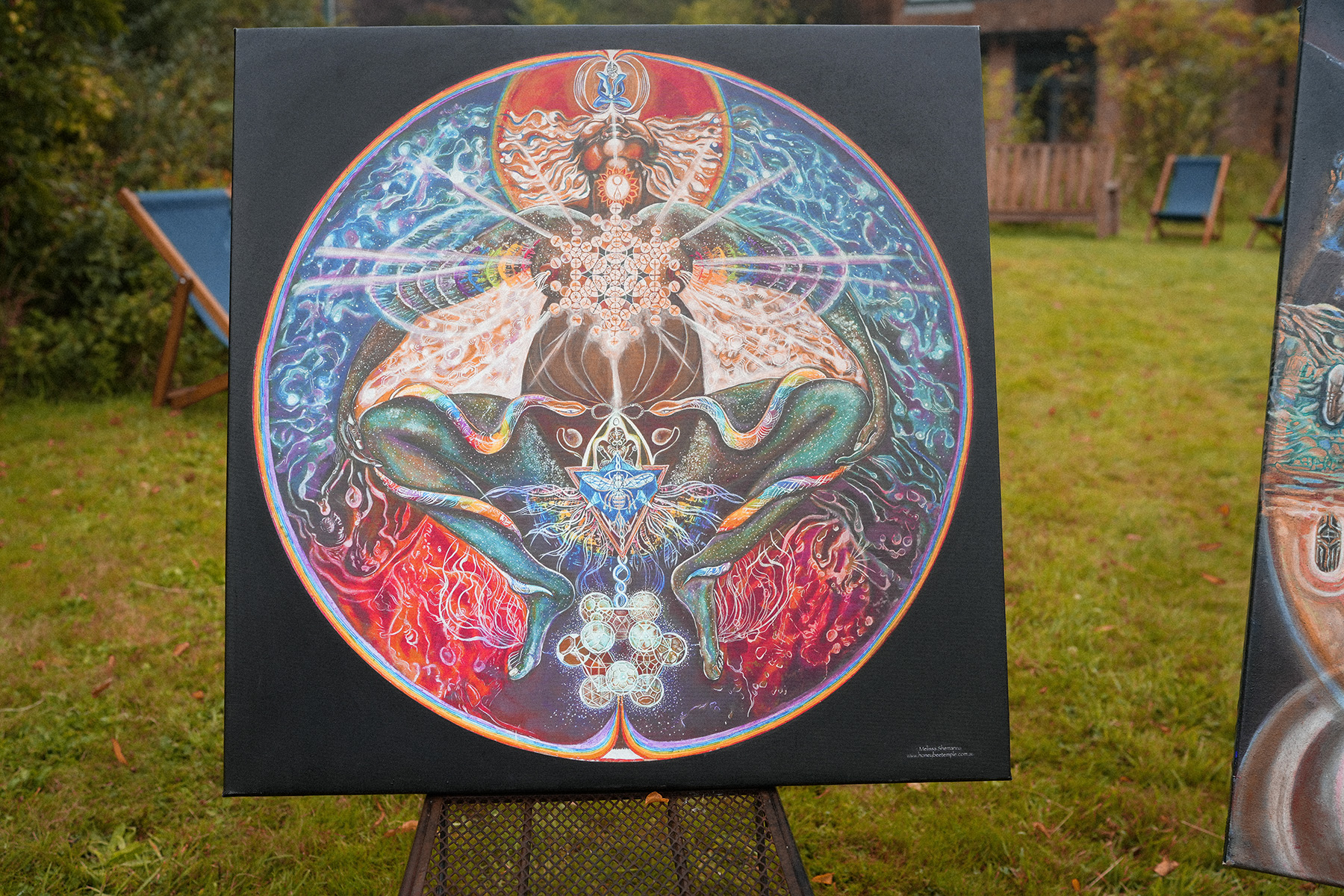
Was there a specific moment or experience that led you to adopt the shamanic style?
Reflecting on this question, I realize that I have always felt at home in the realms of spirit, dreams, meditation, and cosmic experiences. It wasn’t so much a moment when the shamanic way found me, but rather a pathway that I embarked upon as a natural extension of my waking consciousness, already akin to this way of being. My early paintings and drawings already showed a deep interest in the natural and magical spirit realms. During my time at art college in the 90s, my shamanic interests were not understood or encouraged by the institution. However, this only strengthened my resolve and dedication to my personal artistic and shamanic pathway. It propelled me to move beyond the confines of the institution, leading me to start my own Arts Initiative at age 18, called ‘Omniculture’. This initiative evolved over the years and was renamed in 2009 as The Honeybee Temple Arts Foundation, an international private arts foundation for Sacred and Visionary Arts. It focuses on presenting and curating community art rituals, galleries, and events with an emphasis on the humble bee.
Can you describe your creative process from conception to completion of a painting?
The conception of a painting often originates in the dream realms, an inspired thought form, or a knowledge concept that I wish to revive and bring to new understanding. I frequently write conceptually in my series of sketchbooks, which are unstructured, unedited, and free-form. These books often develop seeds of intention for a new piece. Sometimes, it’s an intuition that I feel needs to be birthed into form. I typically begin a painting with a ground layer of oil paint over a sketch of what I aim to compose. My paintings are often complex and require careful visual planning before I start the layering process. However, this approach sometimes changes when I intentionally detach from this planned process to paint freely.

For complex visions, I start layering by rendering or ‘sculpting with light’ using egg tempera, painting the white parts first to sculpt the vision in a monochromatic way. After this, I apply a layer of transparent yellow oil glaze, then go back to sculpting with the tempera whites. I repeat this process with a blue hue oil glaze, and again with the white tempera. This lengthy process creates a luminous, multi-layered effect. Additional colored oil glazes are then applied over this underpainting technique, which brings the shimmering effect of the overall piece to life.

Do you prepare yourself mentally and spiritually before starting a new piece?
Beginning a new piece requires me to be in an alpha brain wave state, with a clear third eye, an attuned heart, and an inspired spirit! Sometimes, I meditate and practice pranayama before and during painting. Other times, I find inspiration through scent by burning sacred resins of incense in my studio. Chanting mantras and making prayer offerings are also meaningful ways to open the pathways for a sacred painting practice.
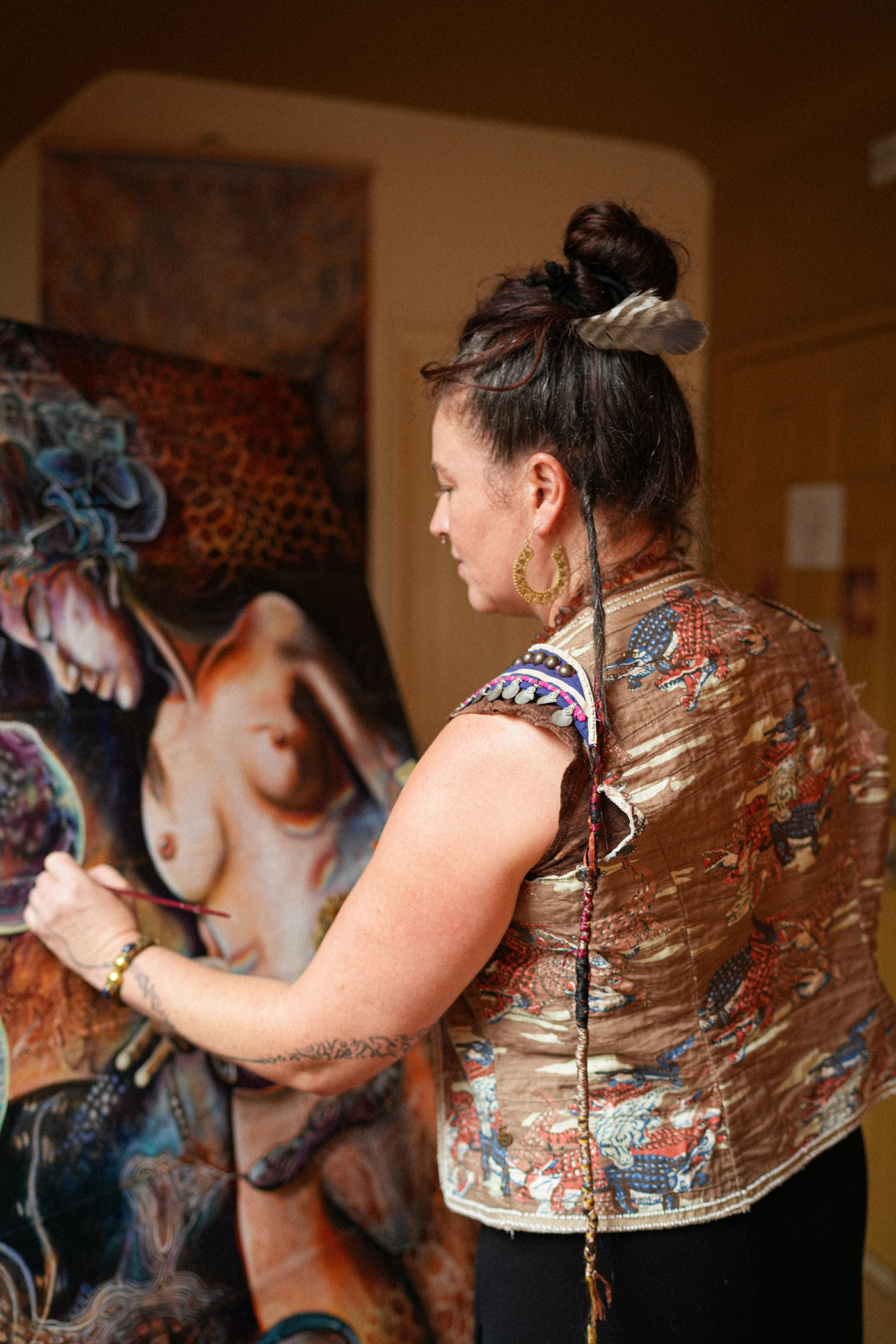
Has your transition from Australia to the UK influenced your artistic style? And what are the biggest differences between life in Australia and in England for you?
The leap of moving from Australia to the UK has been profound for me. The landscape and relationship with the plants and animals here are markedly different, offering me a rich tapestry of new experiences. I am learning so much about the ancient stories and mythology of this land, which resonate deeply with me, as if embedded in my bones and woven into the fabric of my DNA. This mythos is not only deeply inspiring but is also unfolding new layers within my paintings.
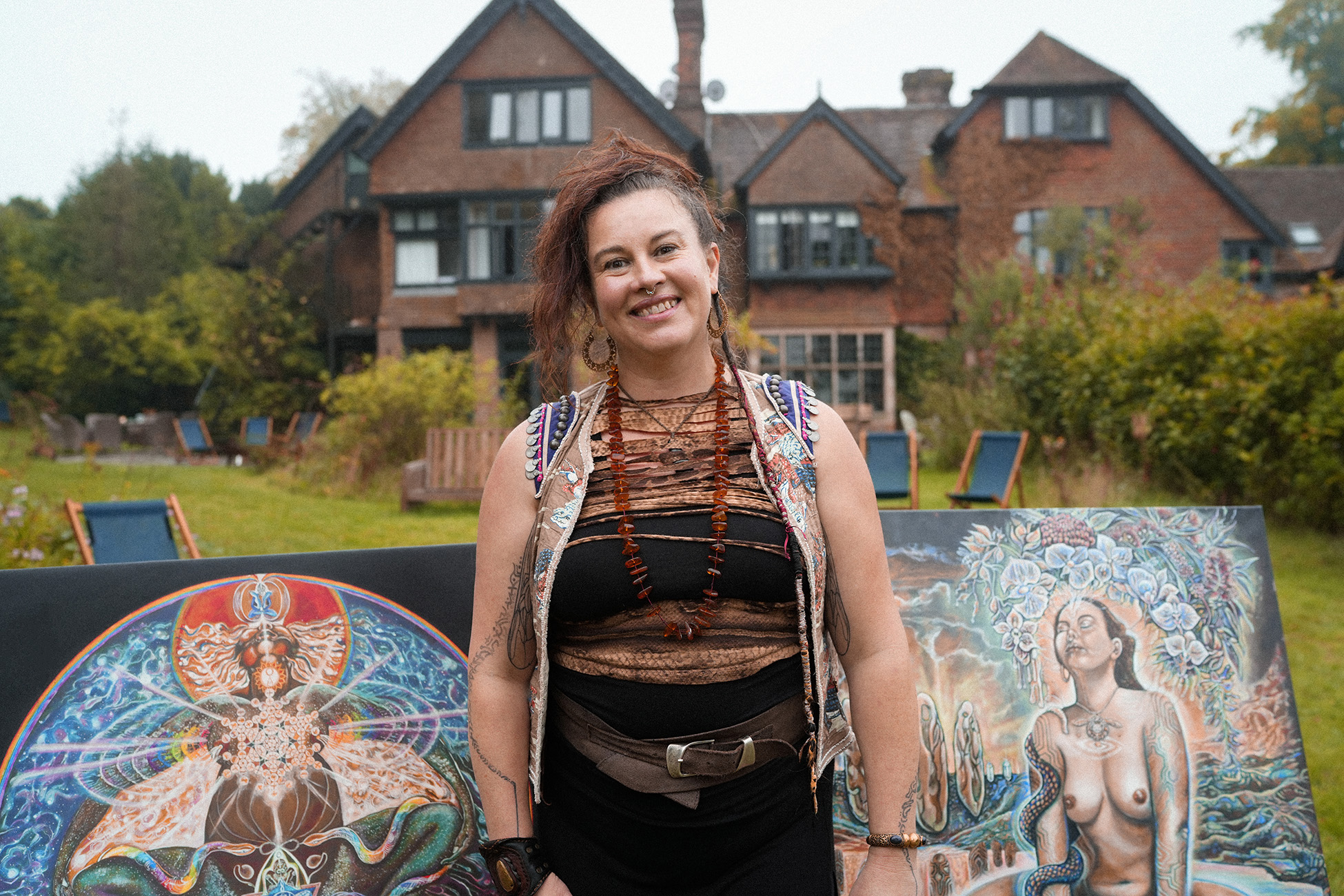
What are some of the biggest cultural differences you’ve noticed, and how have they impacted your work?
One of the biggest cultural differences I would have to say is the relationship with the land here. The people remember the stories and are dedicated to singing them up and retelling them in community groups, much like how the Indigenous people of Australia are inherently connected with their mythos. I love that the knowledge of sacred springs and ley lines is known by just about everyone I meet, rather than a select few. It seems that the land still sings here!
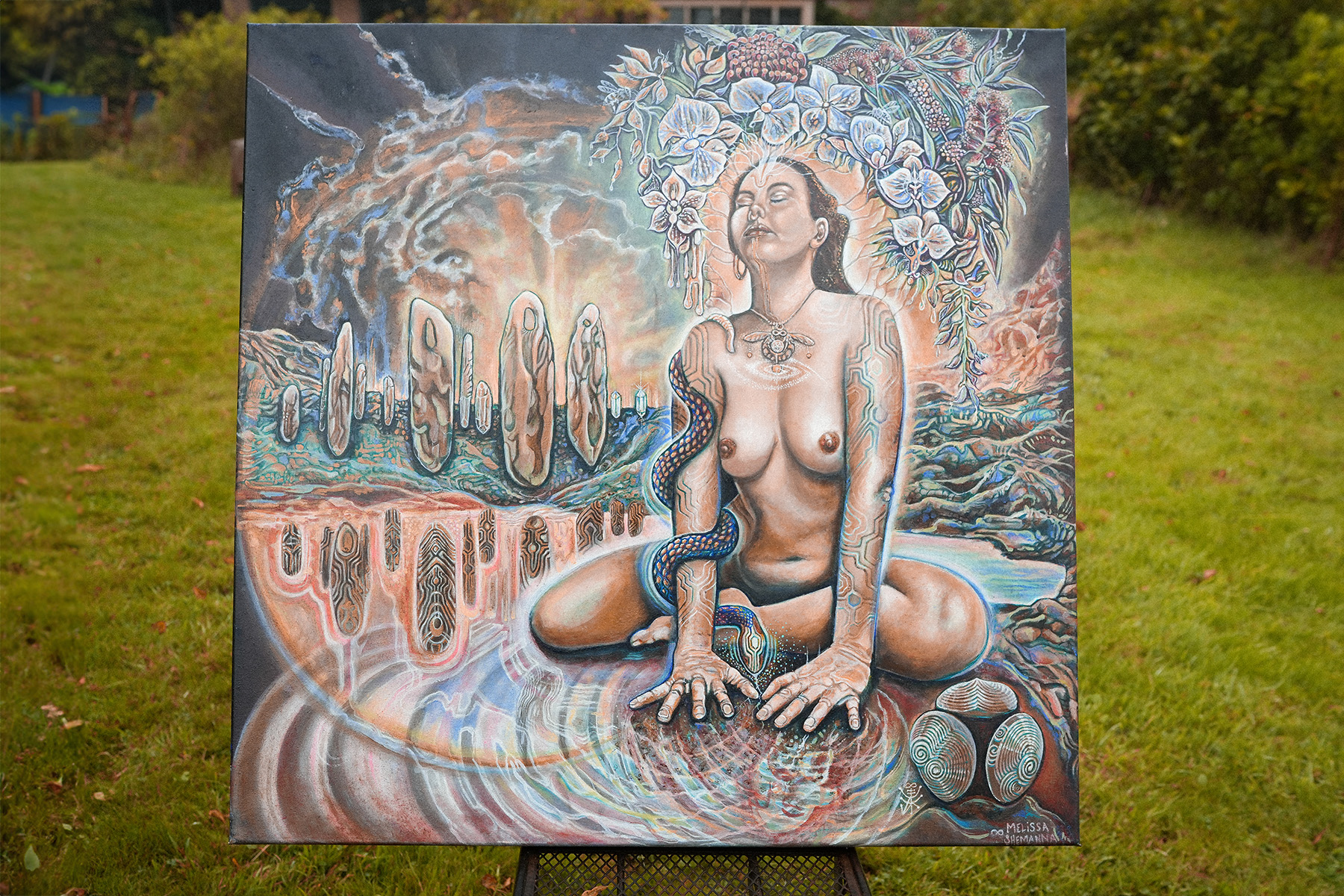
How does the West Sussex countryside inspire your shamanic paintings?
West Sussex is a captivating place, and I have been fortunate to be guided by local wisdom keepers of this land. They’ve shown me the sacred mythological archaeological remains, the standing stones, ancient yew trees, and ancestral rites of passage that are abundant in this fertile land. The forests here are gentle, not as harsh and rugged as the Australian bushland where I grew up. Additionally, the absence of deadly snakes, which I frequently had to be cautious of in Australia, allows for a more relaxed exploration of the natural surroundings here!
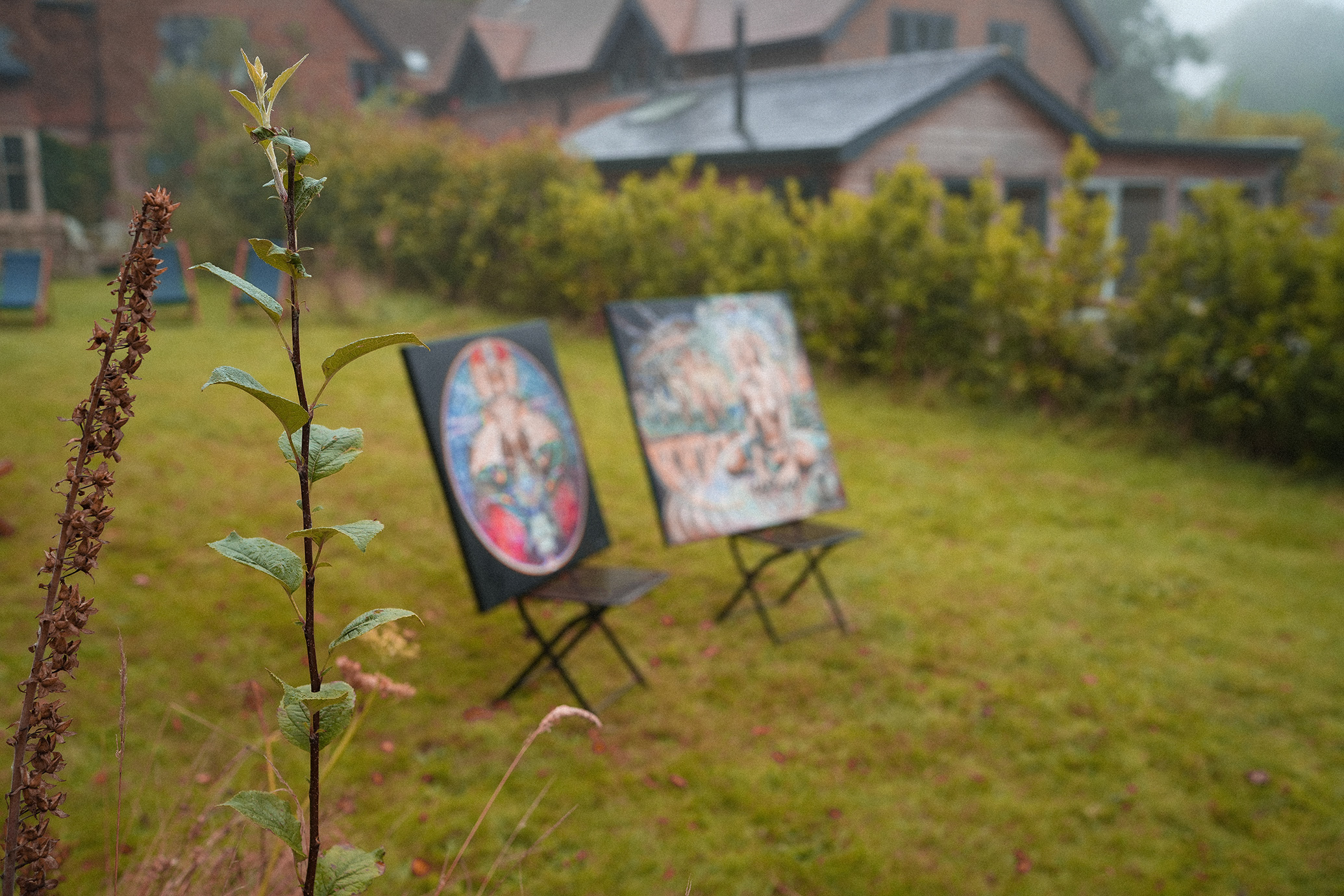
What do you miss most about Australia, and how do you incorporate elements of your homeland into your art?
Mostly, I miss the land and the trees, and the unique animals like wombats, wallabies, goannas, and even the snakes—creatures that are not present here. In Australia, there is a different sense of time; the Dreamtime feels closer, and the ancient rocks tell stories through their song lines in a way that is unlike anywhere else. I also deeply miss my two grown-up sons, Jasper and Liwanu, as well as my family and friends. I strive to keep connected as much as possible. While I do miss them, I am also grateful for this new path in a new terrain that expands my horizons and my artistic career.
What challenges have you faced in your career, and how have you overcome them?
Challenges in my career have included the nature of my art—visionary and shamanic—which initially was not widely accepted in many art galleries in Melbourne or in the international contemporary art scene, although I sense a shift happening now. Another significant challenge, which has also been a profound gift, was being a single mother. I had my first son when I was 22, which impacted my ability to pursue a professional art career when he was young. Additionally, I chose to live off-grid and stay at home to teach and be present with my boys during their formative years. Consequently, my professional art career has been slow to develop, yet this lifestyle allowed me to maintain a creatively pure and spiritually potent way of life, integrating high-level creativity into our everyday existence. Living this dream led me to bring my work to the other side of the world in 2022, with nine original paintings wrapped in my yoga mat. Most recently, in August 2024, I curated an art exhibition for The Medicine Festival, and I am now preparing for an upcoming show in London.
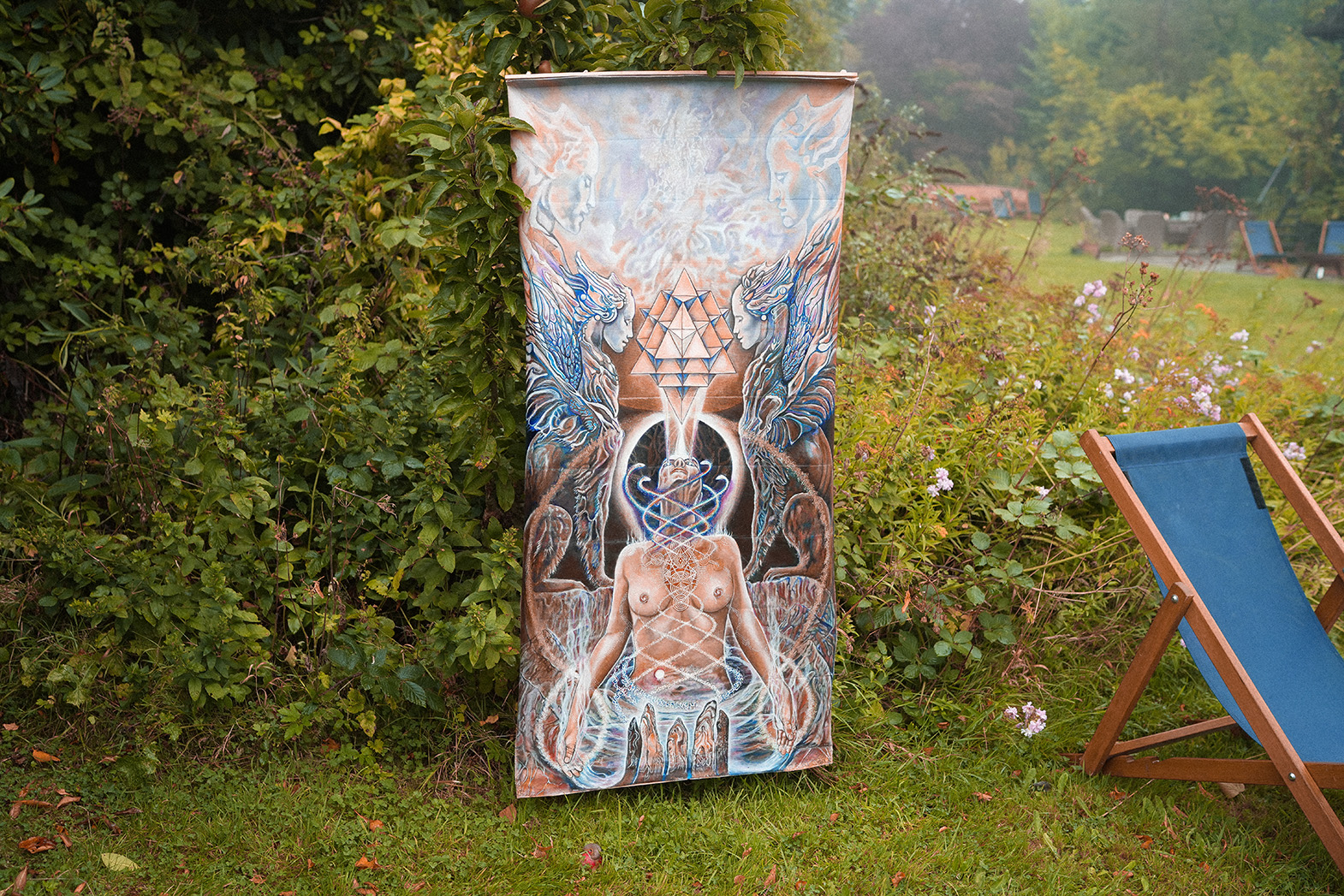
Do you have any future projects or collaborations that you’re particularly excited about?
I’ve just wrapped up a significant project through my arts foundation, The Honeybee Temple Arts Pollinator, which was a pop-up international, visionary, shamanic gallery at The Medicine Festival in August 2024. It was the second time I had the opportunity to curate and manage this massive project, bringing together visionary artists from around the globe. The festival went quite well, and having just completed it less than two weeks ago, my focus is now fully on the ‘Labyrinth of Alchemised Honey’ exhibition in London this September. Post-exhibition, I’m looking forward to a few smaller collaborations through my Arts Foundation for the remainder of 2024, with plans for more expansive projects in 2025. Additionally, I am in the process of writing a book—a working art journal and praxis text on the Oracular Visionary journey of a medicine woman through the triple spiral labyrinth to the inner sanctum. It’s a gradual process, but one I am deeply passionate about.
- Melissa, surrounded by the lush tapestry of the English countryside, stands alongside one of her captivating artworks.
- Melissa’s stunning creation, ‘INANNA – STARFIRE QUEEN,’ emerges as a beautiful, multidimensional masterpiece. This work intricately layers myth and majesty, capturing the essence of the ancient goddess with a vibrant tapestry of color and emotion.
Where do you see your artistic journey taking you in the next five years?
In the next five years, I aim to re-establish my teaching practice, which has been on pause since I left Australia. Having traveled around Europe and the UK for the last 2.5 years without a fixed base, my goal is to find a home suitable for hosting retreats and classes. I plan to build up my teaching sangha, continue creating community art rituals and ceremonies as rites of passage, and further my painting and exhibiting. Additionally, I’m focused on finishing my book and getting it published. Ultimately, I want to find the perfect piece of land where I can realize my long-term dream of creating a sacred Temenos and Honeybee Temple—a welcoming home that opens its doors to friends and family!
What advice would you give to aspiring artists who are struggling to find their unique voice?
To aspiring artists struggling to find their unique voice, I would say: listen closely to your inner voice and the deepest inspirations you feel. Begin to nurture these instincts, because creativity can manifest in myriad forms. Don’t be too hard on yourself—maintain a good sense of humor about the process, but also be disciplined if you’re serious about developing a relationship with a specific creative medium. Consider arranging your home, altar, and creative space in a way that helps you harness and channel creative energies. Dream your artistic identity into being, and let your unique voice emerge naturally.
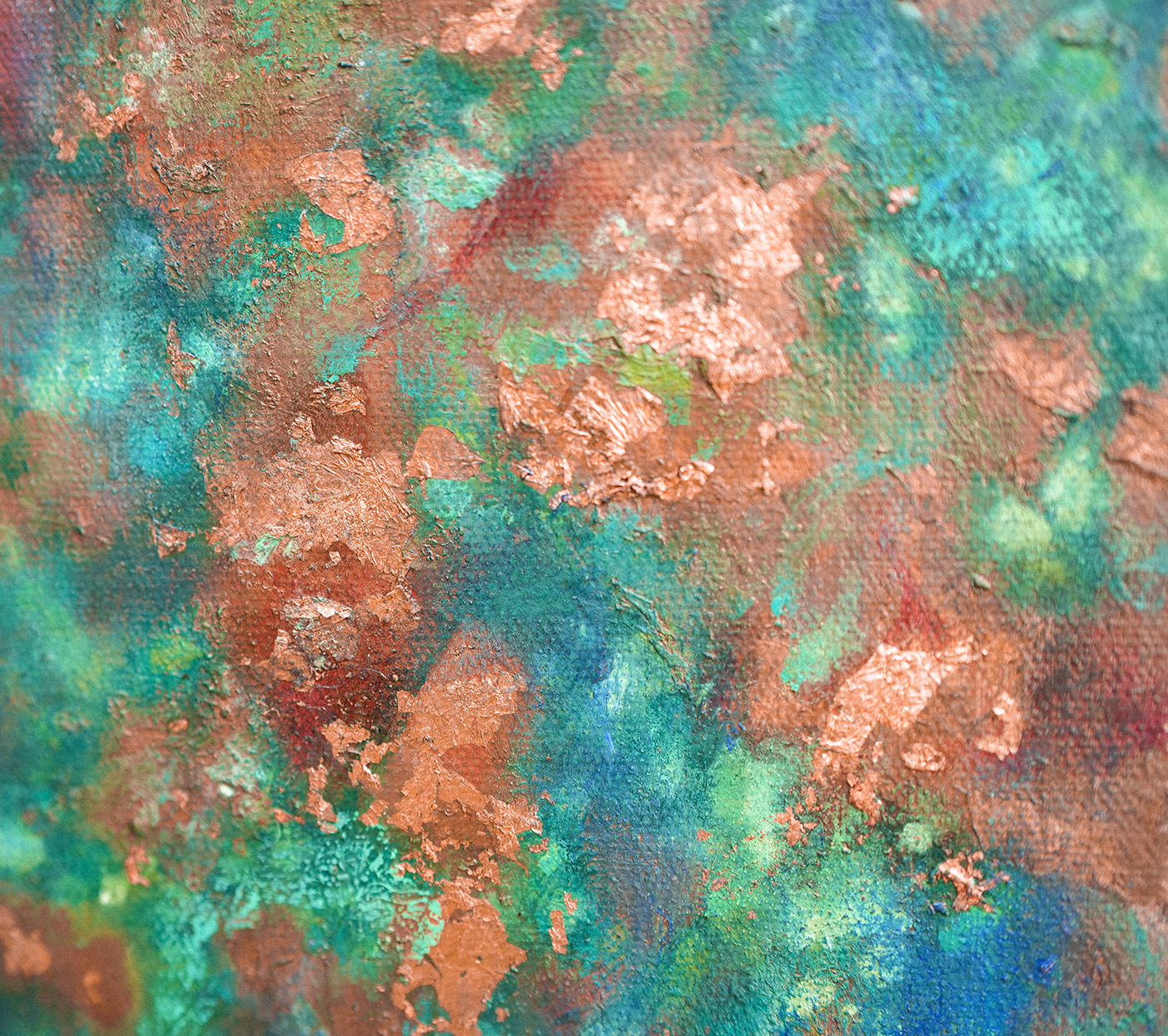
How important do you think it is for an artist to connect with their cultural roots?
Good question—one I love to ponder and philosophize over with friends. Growing up in Australia in a white middle-class family, I was initially immersed in a community somewhat devoid of diverse cultural expressions, which led to mixed feelings of cringe and rejection. However, I was fortunate to have a family deeply interested in Eastern spiritual practices, such as Yoga and Martial Arts, which enriched our lives with creativity and diverse cultural opinions. My personal cultural roots are a complex tapestry—my ancestors hailed from highland Scottish tribes and carried English and Irish blood. They migrated to Australia as convicts and free settlers, making their home in a land that soon became my true cultural influence.
Nature became my culture; the land itself informed my identity and connection to the place I was born and loved. Though I knew my ancestral roots lay elsewhere, I felt a deep connection to the Australian land. This connection drove me to seek mentorship from Indigenous peoples, who guided me and shaped my understanding through ceremonies and sacred landmarks. They helped me appreciate the song lines and allowed the land’s songs to unfold within me. I dreamed with the land, and it bestowed its blessings upon me.
In essence, I have grown to see myself as a child of the Earth—attuned to Gaia, the stars, and the cosmos, embracing the centre of creation within. This profound connection to the natural world forms the core of my cultural identity and artistic expression.
Do you have a favourite piece among your works? If so, why does it hold a special place in your heart?
My favorite piece among my works is titled ‘Ancestral Song lines (Faery Skins)’. It holds a special place in my heart as it represents my profound connection to the Earth and the wisdom she communicates through us. This self-portrait was not just an artistic endeavor but a commitment to live out my purpose and express my fullest self. As a Honeybee Priestess, this piece symbolizes my sacred service to Gaia, bringing forth oracles through the portal of my paintings. It embodies my devotion and the spiritual journey I undertake as I meld my voice with the ancient song lines of the land.
Is there any platform where people can see or purchase your work?
Absolutely, you can view and purchase my work through several platforms. My main website is The Honeybee Temple. You can also find my artwork on social media or contact me directly via email. Here are the details:
- Email: honeybeestarfire@gmail.com
- Instagram: @the_honeybee_temple
- Facebook: Melissa Shemanna
- Facebook Page: The Honeybee Temple Art of Melissa Shemanna
Additionally, you can google my name to find various interviews and articles I’ve participated in over the years. Thank you for this wonderful interview opportunity!
Thank you, Melissa, for the interview!

